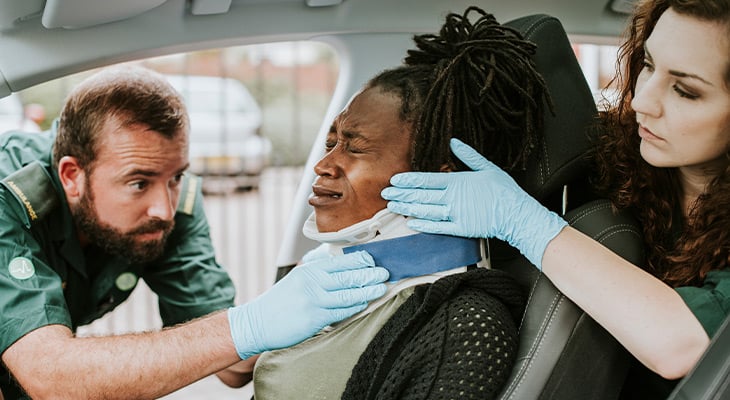Bodily Injury Liability Insurance: What It Is, What It Covers, and How Much You Need
At Compare.com, it’s our mission to find simple ways to help our customers save money on the things they need. While we partner with some of the companies and brands we talk about in our articles, all of our content is written and reviewed by our independent editorial team and never influenced by our partnerships. Learn about how we make money, review our editorial standards, and reference our data methodology to learn more about why you can trust Compare.com.
Bodily injury (BI) liability coverage is one part of a standard liability policy, alongside property damage liability. It provides coverage for others you injure in an accident when you’re at fault.
Liability insurance is required in almost all states, making it a necessary coverage in your car insurance policy.
The average bodily injury claim payout is over $24,000, according to the Insurance Information Institute (Triple-I). So, having the right amount of coverage is crucial — especially in states where you can be sued for damages, pain, and suffering.
Here’s what you should know about bodily injury coverage and how much you need to protect your finances.
Bodily Injury Liability Coverage Explained
Your bodily injury liability coverage pays for injuries you cause to others in a car accident, which can include a driver in another vehicle and their passengers.
Pedestrians, bicyclists, and motorcycle riders are also included under BI coverage. If the other driver is at fault, their bodily injury liability coverage pays for you and your passengers’ injuries.
Let’s take a closer look at what bodily injury liability insurance covers and what it doesn’t.
Find the Coverage That’s Right for You
What Does Bodily Injury Liability Insurance Cover?
Bodily injury liability insurance can cover the following for each injured person:
- Medical expenses
- Pain and suffering
- Lost income
- Funeral expenses
It can also cover your legal defense costs if they file a personal injury lawsuit against you.
It’s important to understand what BI doesn’t cover and how it differs from property damage liability coverage.
What doesn’t bodily injury liability cover?
Bodily injury liability won’t cover:
- Your own medical expenses and lost wages
- Damage to your vehicle
- Property damage you cause
The good news is that you can include other coverages in your auto insurance policy for these expenses. Comprehensive and collision coverages pay for physical damage to your car, while medical payments coverage or personal injury protection (PIP) coverage can pay for your personal medical bills.
Bodily injury liability vs. property damage liability
Property damage liability insurance is the other part of liability coverage. It pays for property damage you cause in an auto accident.
Let’s say you rear-end someone, damaging their car and injuring the driver. The bodily injury portion of your liability insurance covers their medical costs and lost wages if they miss work for accident-related medical treatment. The property damage side pays to repair or replace their vehicle.
How Much Does Bodily Injury Liability Insurance Cost?
Bodily injury insurance is combined with property damage to make up the whole of liability coverage. The average cost of liability insurance is $131 per month, according to Compare.com data.
The total cost of coverage can vary by the policy limits you choose and other factors, like your driving record and the insurance company you choose.
The amount of bodily injury coverage you need depends on a few factors, which we’ll discuss below.
How Much Bodily Injury Coverage Do You Need?
You must have at least the minimum coverage limits your state requires for bodily injury in order to legally drive. But it’s a good idea to buy bodily injury limits high enough to cover your net worth — your assets minus your debts. The most expensive part of a motor vehicle accident is usually medical care.
When you purchase bodily injury coverage, it comes as a split limit that determines the maximum amount your policy will cover. Here’s what that means.
Per-person limit
The per-person limit is the most your insurer will pay for each person injured in an accident that you caused. So if your per-person limit is $50,000, the most your bodily injury liability coverage will pay for medical costs and lost wages for one person is $50,000.
Per-accident limit
The per-accident limit applies when multiple people are injured. If you have a $100,000 per-accident limit and three people are injured, the most your policy will pay for all injuries and other injury-related expenses is $100,000.
You can find these limits listed in your policy declarations page and full policy contract.
Why you should consider purchasing higher limits
Even if you buy your state’s minimum coverage limits, they may not sufficiently cover your financial responsibility after an accident. Purchasing higher coverage limits is often worth it — especially if you have assets you want to protect. Plus, the average cost of a new car is higher than the minimum property damage limit in many states.
The bottom line is that you can be personally liable for expenses exceeding your policy limits in many states. If you can’t pay, you could have your wages garnished or a lien placed against your assets.
Minimum Bodily Injury Liability Requirements by State
Each state has a different minimum amount of bodily injury coverage. This coverage isn’t required in Florida, and it’s optional in New Hampshire as long as you can prove you have the funds to meet your financial responsibility if you cause an accident.
The table below shows the lowest limits state laws require for a split limit policy.
| State | Per-Person Bodily Injury Minimum | Per-Accident Bodily Injury Minimum |
|---|---|---|
| Alabama | $25,000 | $50,000 |
| Alaska | $50,000 | $100,000 |
| Arizona | $15,000 | $30,000 |
| Arkansas | $25,000 | $50,000 |
| California | $15,000 | $30,000 |
| Colorado | $25,000 | $50,000 |
| Connecticut | $25,000 | $50,000 |
| Delaware | $25,000 | $50,000 |
| Florida | N/A | N/A |
| Georgia | $25,000 | $50,000 |
| Hawaii | $20,000 | $40,000 |
| Idaho | $25,000 | $50,000 |
| Illinois | $25,000 | $50,000 |
| Indiana | $25,000 | $50,000 |
| Iowa | $20,000 | $40,000 |
| Kansas | $25,000 | $50,000 |
| Kentucky | $25,000 | $50,000 |
| Louisiana | $15,000 | $30,000 |
| Maine | $50,000 | $100,000 |
| Maryland | $30,000 | $60,000 |
| Massachusetts | $20,000 | $40,000 |
| Michigan | $20,000 | $40,000 |
| Minnesota | $30,000 | $60,000 |
| Mississippi | $25,000 | $50,000 |
| Missouri | $25,000 | $50,000 |
| Montana | $25,000 | $50,000 |
| Nebraska | $25,000 | $50,000 |
| Nevada | $25,000 | $50,000 |
| New Hampshire | Optional | Optional |
| New Jersey | $25,000 | $50,000 |
| New Mexico | $25,000 | $50,000 |
| New York | $25,000 | $50,000 |
| North Carolina | $30,000 | $60,000 |
| North Dakota | $25,000 | $50,000 |
| Ohio | $25,000 | $50,000 |
| Oklahoma | $25,000 | $50,000 |
| Oregon | $25,000 | $50,000 |
| Pennsylvania | $15,000 | $30,000 |
| Rhode Island | $25,000 | $50,000 |
| South Carolina | $25,000 | $50,000 |
| South Dakota | $25,000 | $50,000 |
| Tennessee | $25,000 | $50,000 |
| Texas | $30,000 | $60,000 |
| Utah | $25,000 | $65,000 |
| Vermont | $25,000 | $50,000 |
| Virginia | $30,000 | $60,000 |
| Washington | $25,000 | $50,000 |
| Washington, D.C. | $25,000 | $50,000 |
| West Virginia | $25,000 | $50,000 |
| Wisconsin | $25,000 | $50,000 |
| Wyoming | $25,000 | $50,000 |
How to File a Bodily Injury Liability Claim
If you’re injured in an accident, take these steps to file a BI claim:
- If you or someone else is injured, the first step is to call 911. The dispatcher can get an ambulance to the scene to assess injuries and have a police officer come to take an accident report.
- While waiting for the police and an ambulance, take photos of the scene if you can. Photograph the accident location, street signs or markers, and each vehicle’s sides, including the license plates.
- After both drivers have provided their personal contact and insurance information to the police, take down the officer’s badge number, name, and police report number. Be sure you have the at-fault driver’s insurance information as well.
- Call the other driver’s insurance company to file the claim or use the company website or mobile app. Provide all the information you just gathered.
Liability Car Insurance FAQs
Bodily injury liability car insurance is essential coverage to protect yourself financially. We answered some of the most common questions about BI coverage below.
Do you need bodily injury liability car insurance?
Typically, yes. You need bodily injury liability car insurance if your state requires it. Failure to purchase your state’s minimum BI liability coverage can result in a fine for driving without proper insurance. You can also be held financially liable if you cause an accident where others are injured.
What’s the best amount for bodily injury liability?
The best amount for bodily injury liability is enough coverage to protect your net worth. If your net worth exceeds the limits that an insurance company offers, it might make sense to buy umbrella insurance. It can cover you if you exhaust your liability limits in an at-fault accident.
Is personal liability the same as bodily injury?
No. Personal liability usually refers to coverage in your homeowners or renters insurance policy that protects you if someone injures themselves on your property. It differs from bodily injury, which protects you if you cause injuries to another person while driving your car.
Is bodily injury coverage expensive?
It depends. Bodily injury coverage costs depend on factors like your age, driving record, coverage limits, and insurance company. The higher the limits you choose, the more expensive it is. But liability insurance is much cheaper than paying out of pocket for injuries you cause in an accident. The average bodily injury claim is over $24,000, according to Triple-I.
What does it mean if the coverage limits are $25,000/$50,000?
Bodily injury limits of $25,000/$50,000, or 25/50, are split limit coverages. It means your policy will pay $25,000 per person for injuries you cause and $50,000 per accident. If you cause injuries to multiple people, the most your policy will pay is $50,000.
Sources
- Insurance Information Institute, “Facts + Statistics: Auto insurance,” Accessed November 10, 2023.
Compare Car Insurance Quotes
About Compare.com
Compare.com’s #1 goal is to save you money. We publish resources that are based on hard-hitting data and years of industry experience to help you make more informed decisions with your wallet.
- All of Compare.com’s content is written and reviewed for accuracy by a team of experienced writers and editors who are experts on the topics they cover.
- None of Compare.com’s content is ever influenced by the companies and brands we partner with.
- Compare.com’s editorial team operates independently of any of the company’s partnership or business development interests. We publish unbiased information strictly for the benefit of our readers.
- All of the content you see on Compare.com is based on comprehensive analysis and all data is gathered and vetted from trustworthy sources.
Learn more about us, our team, and what makes us tick.








